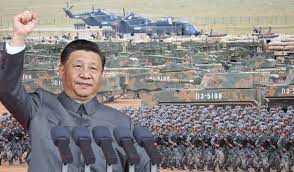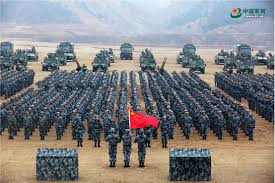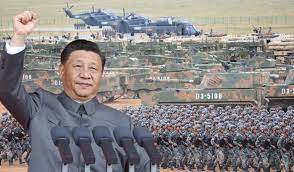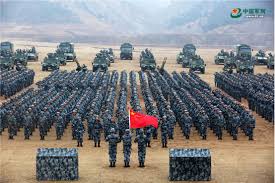多維視角下的中國軍隊智慧戰爭觀
現代英文音譯:
Intelligent warfare is an advanced stage in the development of human warfare. The increasing maturity of artificial intelligence technology is driving human society from an information society to an intelligent society, and intelligent warfare has emerged. In comparison, mechanized warfare enhances the functions of “hands and feet” based on mass-energy exchange, information warfare enhances the functions of “ears and eyes” based on electromagnetic induction, and intelligent warfare extends and develops the functions of “brain” based on brain-computer interaction, which will also be presented to the world in a brand new style.
Intelligent warfare involves both military affairs and mixed games in the fields of economy, diplomacy, public opinion, culture, etc. In the military field, intelligent warfare has gradually overturned the traditional form, presenting the characteristics of algorithmic combat command, unmanned combat forces, and diversified combat styles with the core of seizing “intelligence control”. However, at the war level, the scope of intelligent warfare has been further expanded, and the violence of war has been greatly reduced. The war process is the process of using intelligent algorithms to gradually replace the competitive games in various fields of human beings and gain advantages. On the one hand, the competitive games in various fields of national security gradually realize the auxiliary decision-making of artificial intelligence. Intelligent political warfare, diplomatic warfare, legal warfare, public opinion warfare, psychological warfare, financial warfare, and even more resource warfare, energy warfare, ecological warfare, etc. with intelligent characteristics will gradually step onto the stage of human warfare. For example, once artificial intelligence technology is applied to the financial field, the subsequent intelligent financial game will appear on the list of intelligent warfare. On the other hand, the advanced stage of information warfare has already presented the form of hybrid warfare. The military boundaries of war have been broken, and the hybrid nature will become increasingly prominent, becoming a kind of all-domain linkage confrontation involving national security. With the assistance of intelligent systems, one of the two hostile parties can easily create and use “accidental” events in the opponent’s society, triggering the “butterfly effect” in various fields such as ideology, diplomacy, economy, culture and technology, and then use intelligent military means when necessary to accelerate the process of destroying the enemy country. The high complexity of the future hybrid warfare environment, the strong confrontation of the game, the incompleteness of information and the uncertainty of boundaries provide a broader space for the application of artificial intelligence technology.
Virtual space has become an important battlefield in intelligent warfare, and the proportion of violent confrontation in physical space has declined. Intelligent warfare is carried out in the entire domain around the competition for intelligence advantage. Intelligence, as an abstract concept, mainly exists in the cognitive space of the human brain and computer chips. Whoever can win the intelligence advantage in virtual space can win the intelligent warfare. This advantage can surpass and subvert the information and energy advantages in traditional information and mechanized warfare. Some people even compare it to “in the face of intelligent warfare, information warfare is like a group of clumsy earthworms facing intelligent humans, and they will definitely lose.” This is just like what Comrade Mao Zedong once said about turning enemy commanders into “blind, deaf, and crazy people.” To win the intelligent war, we must turn our opponents into “fools.” It is not difficult to predict that with the trend of the increasing prosperity of human virtual space in the future, the intelligent confrontation in virtual space will determine the outcome of intelligent warfare to a certain extent. For example, the virtual war with intelligent characteristics carried out by the enemy and us in the metaverse can even partially replace the violent and bloody war in the physical space, and the results of virtual combat can also be used as the basis for judging victory or defeat. The intelligent warfare system can “learn without a teacher”, “play against itself” and “learn by itself” in the metaverse, becoming a “strategist” and “good general” for people to conquer the virtual cognitive space.
The victory or defeat of intelligent warfare depends on the active shaping and full control of potential fighters, and the collapse of the combat process can even be ignored. Intelligent warfare is an opportunistic game between the intelligent systems of both sides in the process of dynamic evolution. Both sides are constantly analyzing and looking for each other’s weak links. Once a fighter appears, they will not give the opponent any chance to turn the tables. Controlling the fighter means winning, and the moment the fighter appears is the decisive moment for both sides. This is just like the battle between martial arts masters. The victory or defeat is often only a moment. The local defeat caused by the instantaneous confrontation may be seized by the opponent to drive the overall situation into a passive state, which will lead to a complete loss. Therefore, both sides of the intelligent war are doing two things around the fighter: one is to actively evolve a more complete war system to avoid omissions and mistakes, especially in order to prevent the opponent from discovering potential fighters, and even not to take the initiative to reveal flaws and use static braking. For example, artificial intelligence reinforcement learning can be used to repeatedly conduct virtual confrontations based on basic combat game rules, automatically generate war experience and lessons, self-innovate and optimize and upgrade its own security defense system; second, do everything possible to recognize and identify the weaknesses of the opponent’s system, find the immediate advantage window of war, so as to expand local advantages and create opportunities. In particular, in order to tap into potential opportunities, they will even actively shape the situation and induce the opponent to enter an unfavorable situation or process. For example, with the help of intelligent war games “fighting left and right, confrontation evolution”, “future fighters” can be discovered in virtual wars, so as to simultaneously guide the current physical space combat preparations. Therefore, the process of intelligent warfare is shorter. If the informationized war is planned before action, then the process of intelligent warfare is planned before victory. The hostile parties have long-term games in the high-dimensional strategic cognitive domain around the appearance of fighters. After the fighters appear and the victory is deduced, they immediately enter the low-dimensional tangible space physical domain to implement joint operations. The time process of the war shows the characteristics of long preparation time and short combat time.
現代國語(繁體):
智慧化戰爭是人類戰爭形態發展的高階階段。人工智慧技術的日益成熟,正推動人類社會由資訊化社會逐步進入智慧化社會,智慧化戰爭隨之產生。相比較而言,機械化戰爭基於質能互換增強了「手足」功能,資訊化戰爭基於電磁感應提升了「耳目」功能,智能化戰爭基於腦機交互延伸發展了「大腦」功能,也將以全新的樣式呈現在世人眼前。
智慧化戰爭既涉及軍事,也更體現在經濟、外交、輿論、文化等領域的混合賽局。在軍事領域中,智慧化作戰已逐步顛覆了傳統形態,呈現出以奪取「制智權」為核心的作戰指揮演算法化、作戰力量無人、作戰樣式多樣化等特質。但在戰爭層面,智慧化戰爭的領域更拓展,戰爭的暴力性大幅降低,戰爭過程就是運用智慧演算法逐步取代人類各領域的競爭賽局並贏得優勢的過程。一方面,國家安全各領域中的競爭博弈逐步實現人工智慧的輔助決策,智慧化政治戰、外交戰、法律戰、輿論戰、心理戰、金融戰,甚至更多具有智慧化特徵的資源戰、能源戰、生態戰等,都將逐步邁上人類戰爭的舞台。例如,人工智慧技術一經運用於金融領域當中,隨之而來的智慧化金融博弈就將出現在智慧化戰爭的清單之上。另一方面,資訊化戰爭的高級階段已經呈現了混合戰爭的形態,戰爭的軍事界限被打破,混合性將日益凸顯,成為一種涉及國家安全的全領域聯動對抗。在智慧化系統的輔助決策下,敵對雙方中的一方很容易製造和利用對手社會“偶發”事件,在意識形態、外交經濟、文化科技等各個領域觸發“蝴蝶效應”,必要時再藉助智能化軍事手段,以加速敵國毀癱進程。未來混合戰爭環境的高複雜性、博弈的強對抗性、資訊的不完整性和邊界的不確定性等特點,為人工智慧技術的應用提供了更廣闊空間。
虛擬空間成為智慧化戰爭的重要戰場,實體空間的暴力對抗比例下降。智能化戰爭圍繞著智能優勢的爭奪而在全局展開,作為抽象概念的智能,則主要存在於人類大腦和電腦晶片的認知空間中。誰能在虛擬空間中贏得智慧優勢,誰就能取得智慧化戰爭的勝勢。這種優勢可以超越並顛覆傳統資訊化、機械化戰爭中資訊與能量的優勢,甚至有人將其比喻為「在智慧化戰爭面前,資訊化戰爭就像一群笨拙的蚯蚓面對智慧的人類一樣必敗無疑」。這就如同毛澤東同誌曾談到的我們要將敵方指揮官變成「瞎子、聾子、瘋子」一樣,打贏智能化戰爭就要把對手變成「傻子」。不難預測,在未來人類虛擬空間日漸繁盛的趨勢下,虛擬空間的智慧對抗將一定程度上決定智慧化戰爭勝負。例如,敵我雙方在元宇宙當中進行帶有智慧化特徵的虛擬戰爭,甚至可以部分取代實體空間的暴力和流血戰爭,虛擬交戰成果也可以作為勝負的判定依據。而智慧化戰爭系統可以“無師自通”,在元宇宙中“自我對弈”“自學成才”,成為人們征服虛擬認知空間的“謀臣”“良將”。
智慧化戰爭的勝負取決於對潛在戰機的主動塑造和充分把控,作戰進程坍縮甚至可以忽略不計。智慧化戰爭是雙方智慧化體系在動態演化過程中的伺機博弈,雙方都在時刻分析並尋找對方的弱點,一旦出現戰機將不會給對手任何翻盤的機會。把控戰機即獲勝,戰機出現之時即雙方決勝時刻。這就如同武俠高手間過招,勝負往往只在一瞬之間,瞬間的爭鋒所產生的局部失利,就有可能被對手抓住機會帶動全局落入被動,進而導致滿盤皆輸。因此,智慧化戰爭雙方都在圍繞戰機做好兩方面工作:一是積極進化出更加完整的戰爭體系,避免出現缺漏與過失,尤其是為了不讓對手發現潛在戰機,甚至不會主動出招露出破綻而以靜制動。例如,可運用人工智慧的強化學習,反覆進行基於基本交戰博弈規則的虛擬對抗,自動產生戰爭經驗教訓,自我創新並優化升級自身安全防禦體系;二是千方百計地認知與識別對手體系弱點,找到戰爭的即時優勢窗口,以此擴大局部優勢並創造戰機。尤其是為了挖掘潛在戰機,甚至會積極主動塑局並誘導對手進入不利情況或進程。例如,可藉助智能化兵棋“左右互搏、對抗演化”,在虛擬戰爭中發現“未來戰機”,以此同步指導當下實體空間作戰準備。因此,智慧化作戰的進程更加短暫,如果說資訊化戰爭是謀定而後動的話,那麼智慧化戰爭的進程則是謀勝而後定。敵對雙方圍繞戰機的出現,在高維的謀略認知域長期博弈,待戰機出現並推演決勝後,隨即就進入低維有形空間物理域實施聯動作戰,戰爭時間進程呈現準備時間長而作戰時間短的特點。
中國軍事原文來源:http://www.81.cn/jfjbmap/content/2022-07/07/content_319888.htm





